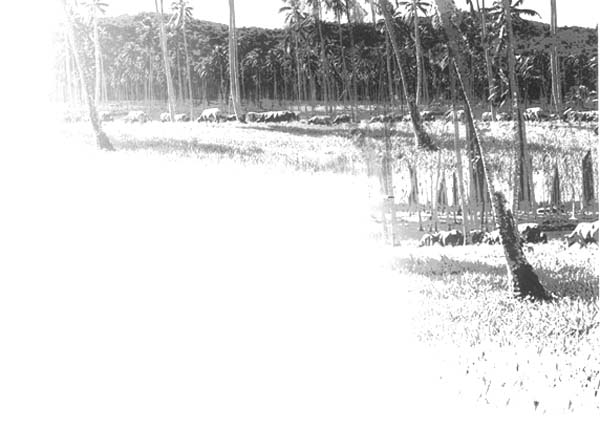
Summary
This chapter provides an overview of the production potential and constraints of grazed livestock production at the farmer or community level. Its aim is to indicate the types of proven, cost-effective technologies and approaches which represent major opportunities for Southwest Pacific farmers in improving their production. This information should assist decision makers in understanding the potential for improvement and the bases for projections that are made in this publication.
In addition to improved feeding and nutrition, the enhanced and consistent use of basic animal husbandry practices are essential for achieving potential levels of livestock production in the Southwest Pacific. The chapter describes basic husbandry practices such as watering, shelter, parasite management, dehorning and castration, breeding and other factors.
Across the range of grazing ecosystems in the region, the quantity and the nutritive quality of daily forage consumption is the prime determinant in the ability of environmentally adapted ruminant genotypes to grow, reproduce, lactate and provide draught power. This is also true of the performance of foraging non-ruminants. The chapter outlines the nutrient needs of ruminants and describes practical agronomic approaches to maximising the quantity of feed consumed, its nutrient content and its digestibility.
These include the use of high-yielding and high nutritive value grasses and legumes, and the correction of soil fertility constraints where necessary and where economic. Direct supplementation of animals with nutrients that are not optimally provided by native or introduced forages, and the avoidance of anti-nutritive factors in forages, are also discussed. The chapter emphasises the importance of cost-effective establishment of well-adapted pasture species into grazing landscapes and of applying ecologically sustainable stocking rates, weed control and catchment management. Such practices will play an important role in realising the potential of livestock production in the region.
Generally, there is potential to raise the reproductive performance (weaning rates) of individual cattle in the region by at least 50% and post-weaning growth rates by up to 50%. Similarly, growth rates of sheep and goats can be almost doubled. A doubling of milk production on an individual animal basis is also achievable.
The application of regionally proven technologies, many of which are referred to in this publication, has the capacity to markedly improve per-hectare productivity. Examples of enhanced animal production include:
25–75% gains by incorporating a stable 10–30% legume component in grass-only pastures;
three- to fourfold gains in < 2000 mm rainfall areas and doubled production in > 2000 mm rainfall areas by replacing native grass pastures with the best-adapted, improved grass/legume mixtures;
at least a doubling of production by managing weed-infested native or improved pastures; sometimes involving the correction of critical soil nutrient deficiencies and, at times, provision of mineral, energy and protein supplementation.
Box 2 Important non-feeding animal husbandry practices
General
|
Cattle
|
Poultry
|
Pigs
|
Sheep
|
Many Southwest Pacific farmers can achieve rapid productivity improvements for their grazing livestock by altering animal husbandry practices. Productivity is often constrained by sub-standard practices such as inadequate water supply, lack of castration and dehorning, uncontrolled breeding, inbreeding, and little attention to localised disease and endo-and ecto-parasite control. In addition to feeding and management factors, the use of inappropriate animal genotypes is a secondary constraint to regional meat and milk production.
However, basic animal husbandry principles are not always understood by farmers or even by extensionists. Extensionists will often provide information to farmers and farmer groups on production enhancing technologies while ignoring basic animal husbandry practices. In so doing, major opportunities for improving production are missed. Box 2 provides an overview of basic animal husbandry practices which are relevant to livestock producers in the Southwest Pacific.
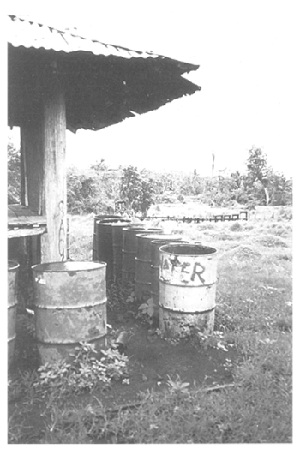 | Farmers who do not have river, reticulated or dam water supplies can collect water for livestock from farm roofs. |
Introduction
Within the diverse grazing systems of the Southwest Pacific, the ability of grazing ruminants to grow, reproduce, lactate and provide draught power is largely a function of the quantity and nutritive quality of daily forage consumption. This is also true of the performance of foraging non-ruminants. For a target level of animal nutrition and a target level of animal production from forages, daily ingested young forage leaf and stem dry matter must have specified levels of protein (nitrogen), metabolisable energy (ME), phosphorus, calcium, potassium, magnesium, sulphur, sodium and trace elements (Box 3).
The quantity and quality of forage produced varies considerably across the region. It is affected by locality-specific environmental factors such as soil type and soil fertility, rainfall, shade, radiation and temperature, and plant-available soil moisture across seasons. It is also affected by the inherent nutritive (and sometimes anti-nutritive) characteristics of selected pasture species and depends significantly on the quality of management of pastures, weeds and grazing animals.
Grazing livestock rely predominantly for their forage intake on native and some introduced grasses along with herbaceous, shrub and tree legumes, other non-legume trees, various weed species and crop residues. In the Southwest Pacific maximum animal production from a particular environment or farming system is largely based on a mix of the best-adapted legumes and one or more grasses. The primary factors which maximise digestible nutrient intake, and hence animal production or work performance, are the quantity of feed consumed, its nutrient content and its digestibility. Practical agronomic responses to these three factors include:
Box 3 Common limiting nutrients in ruminants in the Southwest Pacific
| The most common nutrient deficiency in many native and introduced grass dominant pastures is low nitrogen (1%; 1.5% required). Many pasture species (e.g. signal, guinea and t-grass) are inherently low in sodium (0.02%; 0.05–0.07% required). |
| In regularly burnt native and improved grasslands, in addition to nitrogen deficiency, sulphur deficiency (<0.1%; 0.15% required) is likely to limit animal production. Typical areas include Western Division of Fiji, North and West Noumea in New Caledonia, Kongga and Aruligo grasslands of Guadalcanal, Solomon Islands, and the Markham-Ramu valleys, Huon Peninsula and Central Province of Papua New Guinea. |
| Low phosphorus, which limits pasture growth and animal growth and reproduction, is likely to be worst on acid, high phosphorus fixing soils. In particular, this occurs in the high rainfall areas of Samoa; Central Division of Fiji; central Malaita in Solomon Islands; and in the Sepik area of Papua New Guinea (0.08–0.15% phosphorus in young forage is frequently recorded; 0.18% required). |
| Milk production in the Central District of Fiji, Tonga and in Samoa is frequently constrained by low levels of nitrogen, ME, phosphorus and sodium, and sometimes low sulphur and calcium in consumed forage. Batiki pastures in high rainfall areas of Fiji and Samoa with only 6 megajoules of ME/kg dry feed, are incapable of producing more than 5 litres of milk/cow/day (9–10 megajoules/kg dry matter required for 10 litres/cow/day). |
| Low copper (2–5 ppm; 8–14 ppm required) also restricts growth and reproduction of cattle in some coastal coralline and volcanic soil types in Vanuatu, and is also likely to constrain production in Samoa and in parts of the Markham-Ramu valleys of Papua New Guinea. |
the use of high-yielding and high nutritive value grasses and legumes to increase productivity of nutritionally adequate forage;
the correction of soil fertility constraints where necessary and where economic.
supplementation of grazing animals directly with nutrients which are not optimally provided by native or introduced forages.
Realistic production targets for the Southwest Pacific
Current and potential average commercial animal production indicators for the Southwest Pacific are shown below.
| Current | Potential | |
| Cattle weaning rates (%) | 40–55 | 70 |
| Cattle post-weaning growth rates (kg/head/day) | 0.25–0.35 | 0.4–0.5 |
| Sheep and goat growth rates (g/head/day) | 60–80 | 130–150 |
| Milk production (litres/cow/day) | 4–6 | 10 |
The animal growth rates and milk yields quoted are for the humid tropics. These production figures are less than comparable figures for the temperate regions, due to the lower nutritive value of tropical pastures and higher thermal stress which can reduce feed intake.
Animals growing or milking at different rates have different requirements for daily nutrient intake. This is important for managers seeking maximum production levels. For example, a 400 kg steer growing at 0.5 kg live weight gain (LWG)/head/ day needs a phosphorus content of ingested forage (usually young leaf and stem) of 0.12%, assuming all other nutrients are optimally supplied. Similarly, a 400 kg steer growing at 1 kg/head/day requires a phosphorus content of forage of 0.18%.

Box 4 Farmer responses to nutritional constraints
| Nutritional Constraint | Farmer response |
|---|---|
| Low protein (nitrogen) | Increase legume content of pastures; feed urea plus molasses in dry season; apply nitrogen fertiliser to dairy pastures; supplement with protein meals (dairy, pigs, poultry). |
| Low dietary phosphorus | Supplement with high phosphorus multi-mineral blocks; increase legume contents using low phosphorus adapted species, and apply phosphorus fertiliser if necessary and if cost-effective. |
| Low energy intake | Increase quantities of young pasture regrowth per animal; supplement with copra meal or oil palm derived meals, molasses, cassava, maize or other locally grown high-energy stockfeeds. |
| Low sodium | Provide mineral block or water supplementation; provide access to brackish water; grow sodium-accumulating grasses like Koronivia, buffalo, setarias. |
| Low calcium | Fertilise pastures; provide direct supplements; increase legume in the diet; reduce access to high oxalate grasses like setaria. |
| Low magnesium | Provide direct supplements; increase legume in diet. |
| Low sulphur | Increase legume content of pastures; fertilise if necessary; increase access to high-sulphur grasses like buffalo, Batiki and t-grass. |
| Low copper | Supplement with mineral blocks or sub-cutaneous copper injections; graze older animals on low-copper pastures. |
| Low cobalt | Provide dietary cobalt bullets, but note that a rapid response to vitamin B12 injections indicates a likely response to cobalt. |
| Low iodine | Use high iodine, multi-mineral blocks. |
| Low soil pH | If cost-effective, use lime or beach sand to raise pH to overcome nutritional imbalance created by low pH. |
| Toxins | Vary forages; feed when toxin levels are low or when animals are less susceptible; totally avoid certain forages such as drought-stressed, nitrogenfertilised forage sorghums. Remove toxic plants, e.g. high cyanide bush species such as Pangium edule (or ‘big bol’) that is found in Vanuatu. |
Lactating cows have higher requirements for protein, ME, phosphorus, calcium and sodium intake than growing animals. Dairy cattle need better quality pastures and more supplementary feeding than beef cattle in order to achieve their genetic milk potential in Southwest Pacific environments.
Key areas of nutritional limitation
In some areas of the Southwest Pacific these critical levels of nutritive quality are not met and production falls below potential. Box 3 outlines common nutrient deficiencies for specific areas in the Southwest Pacific and recommends levels of non-limited production; e.g. in beef cattle, 0.6 kg/head/day live weight gain.
Impact of increasing legume contents of animal diets
Farmers can significantly manipulate the quantity and quality of nutrients consumed by using a range of pasture types and supplementation (see Box 4). Increasing the legume content of pastures increases the availability of nitrogen, phosphorus, sulphur, calcium and magnesium to grazing animals. Whilst legumes produce less dry matter than grasses, their digestibility and nutritive value is generally higher than grasses.
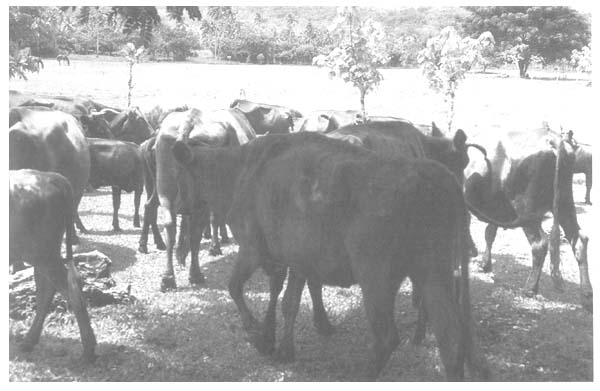
Copper-deficient Illawarra Shorthorn cattle at Montmartre, Efate prior to six-monthly injections of copper gluconate which increased calving from 60% to 80% as well as weaner growth rates.
Provided soil fertility is sufficient to sustain productive legume growth, incorporating and maintaining legumes into protein-deficient grass-dominant pastures is the single most important and cost-effective means of increasing animal production from grazed pastures. For example, in Vanuatu, mechanical costs for establishing legumes are typically around $80/ha. Following legume establishment (about 6–9 months), this investment is normally recovered within the first six months of full stocking. Various research efforts have demonstrated that raising the legume content of grass pastures in the Southwest Pacific and other tropical regions by 0–30% has dramatically increased animal production (Watson & Whiteman 1981; Norton & Alam 1996, Partridge & Ranacou 1974).
It is worth noting, however, that the correction of soil fertility constraints may or may not be economic, depending on input costs, production responses and incremental product value in a particular situation.
Using grasses for specific purposes
Farmers need to be aware of the specific nutritive qualities and environmental adaptation of grasses and use them to their advantage. For example, some grasses like Koronivia and buffalo grass accumulate high levels of sodium. Setting aside a strategic area of such grasses can offset the nutritional deficiency of other low-sodium grasses and legumes on the farm.
Compared to the native t-grass, which is an unpalatable sulphur accumulator, buffalo and Batiki are the most shade-tolerant, palatable, sulphur-accumulating grass species. Para grass and Splenda setaria are well adapted to seasonally wet and waterlogged conditions, while signal is completely intolerant of waterlogging. Creeping grasses such as Batiki, Koronivia and signal are more tolerant of heavy grazing pressure than tall, tufted grasses like guinea, para and setaria. Sabi and Nadi blue grass are well suited to seasonally dry areas with 1000–1800 mm rainfall.
Establishing legumes and improved grasses
In selecting one or more legumes to combine with a preferred grass, a variety of environmental characteristics must be considered. These include soil pH, available soil nutrient levels (particularly phosphorus), potential soil nutrient toxicities, soil depth and seasonal variation in soil moisture, shade and radiation, temperature range, drought, waterlogging and flooding, likely grazing and trampling pressure and the grazing management system proposed.
Within a particular paddock the above soil conditions often vary and different legumes will have specific niches. Thus, planting a mix of legumes will lead to better utilisation of soil resources on a farm. However, there are examples in the region where legume species have been completely mismatched. For example, without liming, leucaena will not establish successfully in soils with pH under 5.5, such as in the high rainfall acidic soil areas of Samoa and the Central Division of Fiji. Further, calliandra has sometimes been incorrectly promoted in areas with extended dry seasons, as in the Western Division of Fiji.
Legumes have different seasonal growth patterns and, as mixtures, maintain a more even digestible nutrient supply to grazing animals than do pure grass pastures. Some other important legumes and grasses in the Southwest Pacific are illustrated below. Other varieties and new species of legumes are emerging with potential to enhance production. (For more detailed information regarding pasture establishment techniques and environmental adaptation of various grasses and legumes, see suggested reading, pp.88–90.)
Augmenting forages with supplements
Excessive wet weather and continuous low radiation under cloudy conditions limits animal growth rates in high rainfall areas of the Southwest Pacific. To maintain reliability of farm output, which is essential for abattoir operators, this limitation to growth can only be overcome by energy supplements such as copra or palm kernel cake, molasses or brewer's grains. Using steers grazing low-quality native pastures, Galgal et al. (1994) achieved 0.93 kg/head/day when supplemented with 1 kg of copra cake/head/day (an estimated 30% of dry matter intake) and 0.25-0.3 kg/head/ day without supplementation.
The economics of feeding energy and/or protein supplements is governed by product prices, production increments obtained and on-farm supplement costs, the latter largely reflecting the variability of transport and raw material costs in the region (e.g. the price per tonne of copra meal, molasses in Samoa is US$50, compared to $200 in Vanuatu). In Papua New Guinea there is major scope for feedlot development close to sources of copra meal, molasses and oil palm cake. More efficient and competitive freight systems could reduce the landed prices of on-farm supplements. Also, the expanded use of coconut oil micro-expeller units could increase the availability of wet copra meal for village pigs and poultry. Direct mineral and trace element supplementation of deficient animals can also have dramatic results at minimal cost.

Box 5 The benefits of improving pastures: some examples
| Nawaicoba Quarantine Station, Fiji. Establishing Koronivia grass together with the legumes centro and hetero into native mission grass country, has increased the quantity and quality of annual forage production. This has led to a tripling of animal production from 0.5 × 400 kg steers gaining 0.25-0.3 kg/ head/day, to 1.2–1.5 × 400 kg steers gaining 0.4 kg/head/day. | |
Koronivia and legumes
invading mission grass at
Nawaicoba.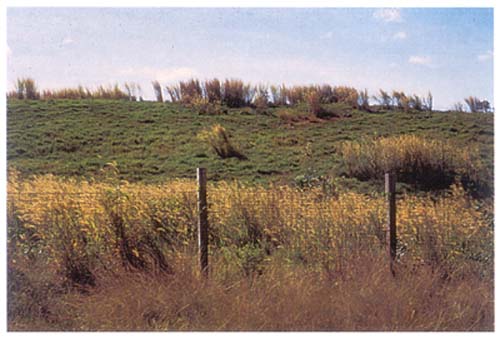 | |
| Melektree dairy, Efate, Vanuatu. Moving milking cows from low legume signal grass to Splenda setaria, with the legumes Tinaroo glycine and greenleaf desmodium, increases milk production from 10 to 13 litres/cow/day within a 24-hour period. Splenda is about 70% digestible whereas signal is about 55% digestible. Also, legumes combine more easily with Splenda than with signal grass and Splenda is naturally higher in sodium, which is more important for milk production than for beef production. Whilst both pasture systems have similar total dry matter production potential, the Splenda-legume system has a higher total level of nutrients and a higher level of availability of those nutrients following digestion. | 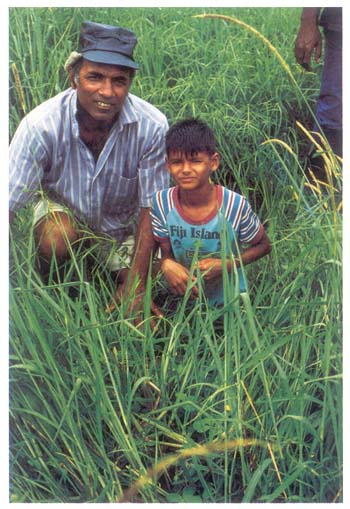 |
| Indo-Fijian dairy farmer and his son in their Splenda setaria and legumes at Tailevu, Fiji. | |
| At Elbee Ranch on Efate, Vanuatu, 25 year-old signal grass pastures oversown with puero, centro, greenleaf desmodium, pinto peanut and Archer axillaris (average 30% pasture) sustain 0.65 kg/head/ day growth in 450 kg Brahman × Simmental steers, stocked at 2.5–3 AU/ha. In comparison, native legume-signal grass pastures sustained 0.53 kg/head/day at 2.5 AU/ha over a nine-year period (Macfarlane unpublished data). | |
 | Signal-sown legume (foreground) outproducing signal only pastures at Elbee Ranch. |
| Batiki/hetero pastures on Savaii, Samoa sustain 2 AU/ha gaining 0.5 kg/head/ day, compared to 0.3 kg/head/day without legumes (STPLSP 1998). | Cattle grazing Batiki-hetero pastures in Samoa. |
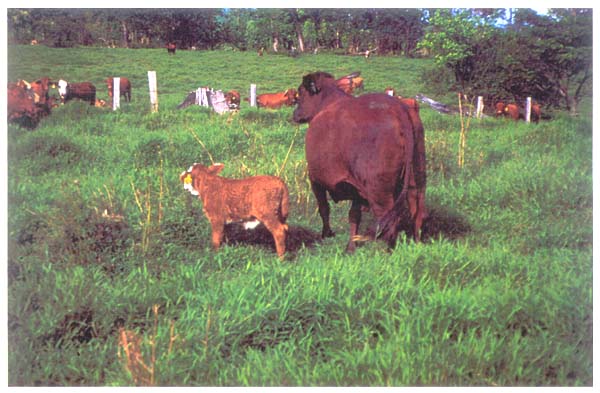 | |
| Planting buffalo grass and the legume hetero into fresh dung pats with cattle still grazing. | 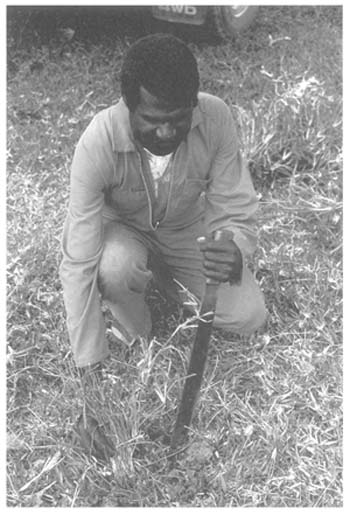 |
| Hand-seeding Glenn joint vetch and centro in Samoa. | |
 | |
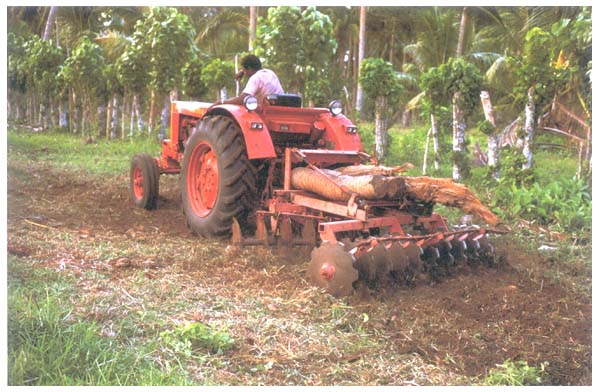 | |
| Disc strip cultivation to establish seeded legumes into an introduced, improved grass (above). | Zero-till seeder used to establish improved pastures with the band spraying of the systemic herbicide glyphosate to remove competition from existing pasture on young seedlings. |
 | |
Other important forage legumes and grasses in the Southwest Pacific*
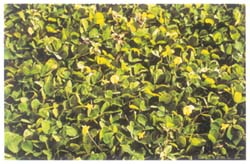 |
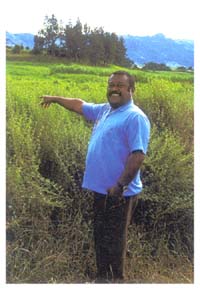 |
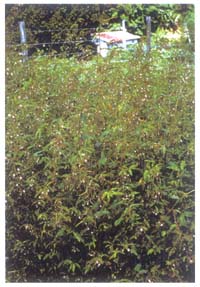 | |
| Above left: Pinto peanut | 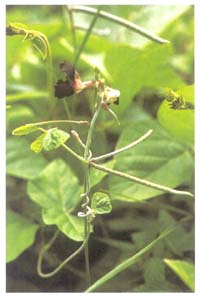 |
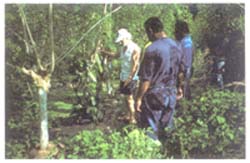 |
Above: Glenn and Lee joint vetch |
| Above centre: seca stylo seed production at Legalega, near Nadi, Fiji. | Gliricidia for fodder or shading, e.g. for vanilla with a greenleaf desmodium ground cover. | ||
| Siratro | 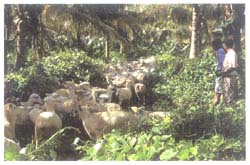 |
Sheep grazing puero on Taveuni, Fiji. | |
| Dolichos lablab as a fallow crop in gardens. | 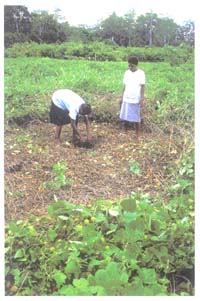 |
 |
The tree legume Leucaena produces quality firewood and forage in specific areas but can dominate environments if ungrazed. |
| Sabi grass | 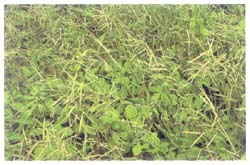 |
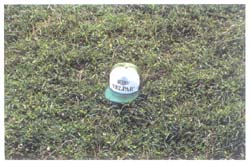 |
Nadi blue grass |
* See Appendix 3 for scientific names.
Managing toxins and anti-nutritive compounds in pastures
Poisoning is most likely to occur during periods of overgrazing, where the availability of quality forage to the grazing animal is inadequate. Animals are thus compelled to consume toxic plants, both indigenous and introduced. Some indigenous forest species such as Pangium edule have high cyanide contents of leaves and fruits which are deadly if consumed. The consumption of common weeds such as Lantana camara, Asclepias curassavica, Derris spp. or Indigofera spp. can also cause death or ill-thrift in the region.
Young cattle in the Markham-Ramu valleys of Papua New Guinea, and sheep throughout the region, should not be grazed exclusively on pure signal grass pastures as photosensitisation and liver damage leads to reduced growth rates and possibly death; saponin compounds are involved (S. Lowe, UNITECH, Lae, pers comm.).
However, the feeding of legumes to improve animal nutrition is not without potential problems. Gutteridge and Shelton (1994) discuss the potential negative impacts of supra-optimal tannin levels from some tree legumes which can inhibit, rather than promote, protein utilisation. Therefore, they generally recommend that tree legumes should not exceed 30% of the diet. Also, most tree legumes need to be fed with caution to mono-gastrics. Using greater than 30% of leucaena in the diet can improve animal production, provided specific bacteria are present in the rumen to detoxify the breakdown products of a specific amino acid, mimosine.
Improving the nutrition of non-ruminants
Simple, low-input feeding and management approaches could improve village pig and poultry survival, growth and, to some extent, reproductive performance. Past government support programmes have too often focused on imported genotypes, intensive systems and imported stockfeeds. Village-based systems have been neglected.
For village pigs and poultry, improved feeding would involve better water access, improved protein intakes through high-quality forage legumes and fish waste, complete use of waste fruits and unused energy stockfeeds like cassava tubers and taro corms (either inedible to or not required by humans), and the feeding of growing or breeding pigs in preference to feeding adult pigs for customary consumption. Other simple management practices which would improve productivity and household food security include reducing internal parasite loads of village pigs by feeding them in dry places, reducing human and other predation of poultry, and preventing the exposure of chicks to wet weather and chilling shock.
In a survey of 253 village pig herds in the Solomon Islands, de Frederick (1979) found mean grower weights of 8.4 kg among 16-week old pigs. Feeding local pigs with above average local stockfeeds comprising sweet potato, coconut, fish waste, legumes and vegetable materials produced the same weight at eight weeks of age. De Frederick showed that with improved diets, infection with kidney worm (Stephanurus dentatus) had minimal negative impact.
In a mixed farming system (crops, pastures and livestock) the soil types with the highest agronomic value are usually best reserved for subsistence and commercial cropping. The greater the land use pressure, the less the justification for large ruminant livestock on arable lands. However, increasing populations or market signals distorted by input subsidies or price support can cause former pastoral lands to be brought into unsustainable long-term crop production. In many cropping systems, greater use could be made of the grazing capacity of livestock to recycle nutrients and to control weeds for mutual benefit. Pastures require lower levels of nutrient inputs to sustain productivity than do other cropping systems. General guidelines on soil-pasture associations and recommended soil fertility levels for non-limiting pasture growth are given in Evans et al. (1992) and in Macfarlane et al. (1998).

| Some commercial pig farmers have halved feeding costs whilst maintaining production levels by substituting imports with local forage legumes and balanced local stockfeed rations. | 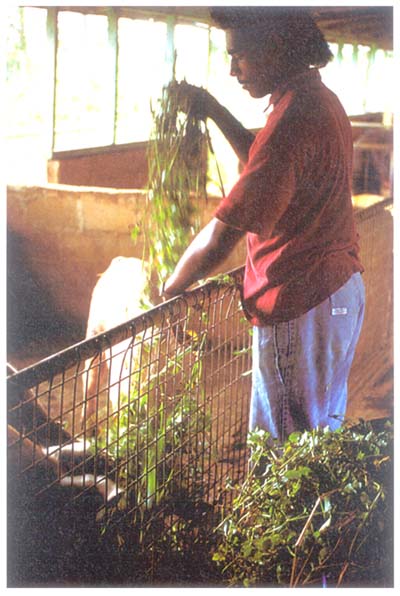 |
Land use and whole farm development planning issues
High costs are involved in using fertilisers to correct nutritional or pH imbalances in the Southwest Pacific. It is preferable to use pasture species which are adapted to low or marginally fertile environments, rather than planting higher nutrient demanding species which require high-input systems. Higher demanding legume and grass species should be reserved for more fertile sites such as those found in valley floors. An example of this is found in the dry zone of Fiji where some progressive farmers have planted leucaena with signal grass, and/or have oversown seca stylo into the infertile native grasslands in upland areas. Farmers are more likely to expend their energy and resources on pasture improvement on those land types that will give the highest initial return. Similarly, grazing animals with the highest physiological demand for nutrients should be grazed on the most productive pasture areas with the best soil fertility. Such approaches seek to minimise risk and to maximise the return on scarce resources invested.
Some acidic soils have high phosphorus fixation capacity. Under these conditions, very little of the applied phosphorus becomes available for plant uptake. In such situations the only viable option is to band apply phosphorus along legume rows, as the broadcast application of whole paddocks will not produce any significant increase in plant-available phosphorus. It should be noted that correction of some soil nutrient deficiencies can also induce other problems. For example, high phosphorus fertiliser and liming rates can reduce the availability of zinc. Similarly, high sulphur intakes from heavily fertilised pastures, or from pastures growing on soils derived from volcanic ash, can reduce the availability of copper in the rumen.
Land fertility and development policy
The capability of land for sustainable production should also be reflected in development policy. The development or rehabilitation of pastures on soils with sub-optimal levels of phosphorus and potassium should be discouraged and made ineligible for development bank or other finance, unless the economics of fertiliser application are clearly positive and widespread adoption is known to occur.
Any improved or native pasture with a 50% coverage of weeds will only achieve about 50% of its carrying capacity and animal production potential. Weed problems will rarely develop if a competitive, introduced pasture system, or a native pasture system, is grazed correctly. It is essential to regularly monitor pasture condition as this guides decisions on grazing management. A good grazing manager uses pasture condition, and not animal condition, as the primary guide in adjusting stocking rates or grazing pressure. A good grazing manager will also eradicate isolated weed populations using manual, chemical, biological or integrated control methods.
Farmers should be constantly looking for slight changes in weed populations that indicate excessive grazing pressure. Periods of overstocking will cause loss of pasture vigour and ground cover, which usually induces major weed ingress. However, poor establishment of an improved pasture can also lead to weed ingress. This can result from inadequate seedbed preparation, the use of poor-quality seed and/or poorly adapted seed species, and from sowing seed into areas of marginal soil moisture.
Mullen et al. (1993), Evans et al. (1993) and Macfarlane et al. (1991, 1998) provide details on weed identification and on integrated weed management and rehabilitation programmes, including the safe and cost-effective use of low toxicity herbicides (see suggested reading, pp. 88–90).
Rehabilitation strategies
Some pasture rehabilitation strategies can be relatively simple and cost-effective. For example, in 1989 the Tisman Plantation on Malekula, Vanuatu, seeded glycine into strips of carpet grass infested with wild tobacco weed. By 1990, the glycine had smothered the weed and had raised growth rates from 250 kg LWG/ha/yr to 500 kg LWG/ha/yr. The establishment cost of this pasture was $60/ha.


Cattle grazing lands of wild tobacco weed-carpet grass (background) and an area oversown with glycine (foreground).
Alternatively, seasonally aggressive climbing legumes like puero, calopo, glycine, or Convolvulaceae weeds can be overcome by very high instantaneous stocking rates which thoroughly defoliate and/or trample the dominant species. The case studies which follow provide further examples of effective rehabilitation, and illustrate the environmental and economic impact of improved land use.
In the 22 member Pacific Island Countries and Territories (PICTs) of the Secretariat of the Pacific Community (SPC), the incidence of diseases of ruminant livestock is insignificant by international standards. This has been covered in Section 1.4. For a detailed coverage of diseases of other animals, the reader is referred to Saville (1994).
Inbreeding and inconsistent government policies and programmes with respect to bovine genetic improvement, bull rotation and timely culling are major constraints in Fiji, Papua New Guinea, Samoa, Solomon Islands, and Tonga. However, the private sector continues to support beef cattle genetic improvement in Vanuatu, and in the Markham-Ramu valleys and the Central Province of Papua New Guinea.
Often, inbred cattle will attain only 60% of potential growth rates and mature sizes. There are several instances where smallholders have used the same bull for 15 years. In some localities, up to 15% of smallholders do not have access to bulls of any kind. Commercial farmers are aware of the need to buy or rotate herd bulls every four years. Invariably, bulls cannot be bought as required and those farmers who have been involved in bull exchange have run out of options, making inbreeding inevitable.
Case Study 1
Woman farm manager making profitable business from land rehabilitation Caroline Ernst, Undine Bay Plantation, Efate, Vanuatu
Caroline Ernst manages a breeding/fattening herd of 500 cattle on about 270 ha of grazed native and improved pastures at Undine Bay. The property has been used as a model farm to demonstrate the economics of rehabilitating coconut lands. This farm has an annual programme of rehabilitating these degraded pastures under coconuts.
During the first year of this programme in 1989, lantana-infested areas producing neither harvestable coconuts nor beef were burnt in the dry season, then disc-harrowed and seeded with signal or sabi grass and legumes. Weed growth was fully controlled in the first year and this has ensured minimal regrowth after the pasture was successfully established. The cost of establishing this pasture in 1989 was VT21 000/ha.
The first year of full grazing grossed VT18 525/ha from growing and fattening steers, with a gross margin of about VT10 500/ha. Concurrently, copra income rose from zero to VT15 000/ha, with a gross margin of around VT8000/ha.
| Caroline Ernst and stockmen in nine-year-old signal-legumes pastures in former lantana infestation, Undine Bay, Efate. | 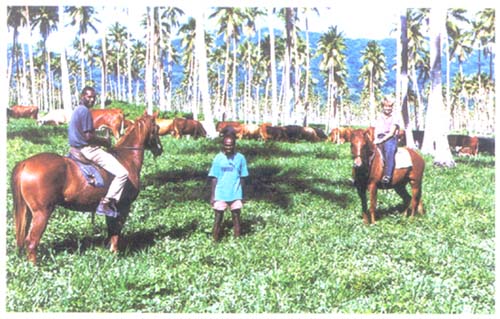 |
Sometimes there are also cultural constraints to rotating or sharing of bulls. Farmers or institutions who rent bulls or provide siring services have had some success. However, even when bulls are available, the lack of affordable freight is a major issue, particularly in Papua New Guinea but also in Fiji and the Solomon Islands.
The non-availability of European-local crossbred breeding pigs and dual-purpose poultry for developing commercial, village-based entrepreneurs is also a significant issue in some countries.
Proven grazing system management and rehabilitation technologies are environmentally positive and offer the most cost-effective options for rehabilitating weed-infested, unutilised or under-utilised land areas in the Southwest Pacific (e.g. 37 000 ha of guava and other weed-infested coconut lands in Samoa). Regionally, there is scope to improve grazing system production by targeting the rehabilitation of existing areas.
Case Study 2
Entrepreneurial ni-Vanuatu farmer and business operator developing his own low-cost rehabilitation techniques Toara Seule, Epule, Efate
Toara Seule manages 120 head of cattle on 60 ha of signal, elephant, buffalo and legume improved pastures. In 1992 Toara rehabilitated 3 ha of a lantana-infested area under his coconuts by burning it after the first rains of the wet season. Siratro seed was then planted in patches and signal grass seed sown into the ash and raked in. Cuttings of elephant grass were hand planted. The elephant grass rapidly shaded other newly emerging pasture species and any lantana regrowth. The shade-affected lantana was hand weeded after about three months.
| Toara Seule's elephant-signal-legume is smothering lantana at Epule, Efate. | 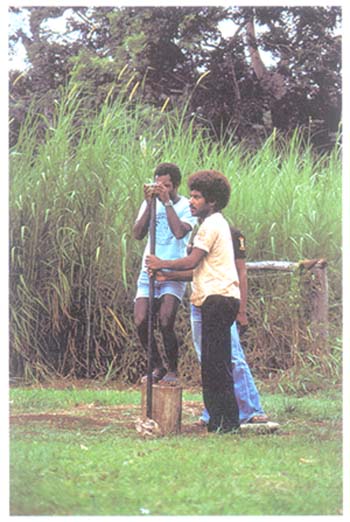 |
Pastures should not be developed on lands of ecological significance. In situations where intensive cropping is eroding steeplands, the conversion of these lands to improved pasture grazing and/or forestry often provides the best long-term environmental and economical alternative.
Pasture land should not encroach within 50 metres of rivers or within 100 metres of foreshores or mangrove lagoons. Grazing should not occur on slopes greater than 15–18 degrees, and slopes steeper than this should revert to bush fallow or be reafforested. Fencing should follow contour lines or soil-type boundaries. Road construction in plantation grazing areas must account for the normal overland flow of flood waters, and on sloping land roads should be sited along contours or ridge lines. Road cuttings and eroded access tracks need to be rapidly revegetated with pasture species to prevent erosion. Stream crossings should be designed to minimize disturbance to river banks.
In existing grazing areas with less than 15% tree cover, reafforestation should be considered along fence lines, in clumps and strips or on land facets which are of lower agronomic value. Areas that are prone to landslips should be destocked and reafforested with up to 150 adapted trees per hectare.
From a catchment management viewpoint, intensive livestock production in an area supplying water for municipal or village consumption is unacceptable. On the other hand, a 50 metre buffer zone between a grazed paddock and a water course is usually sufficient to avoid animal faecal contamination of water.
Key environmental guidelines for grazing systems
The main risk to ecologically sustainable grazing system management is overstocking. Many Southwest Pacific countries can identify some negative environmental impact caused by overstocking, such as weed invasion, landslipping or, in some cases, large-scale erosion. Incorrectly managed and promoted goats on the atoll countries of Kiribati, Tokelau and Tuvalu have had significant negative impact. However, there are also examples of rangeland degradation that has occurred without the presence of grazing animals; e.g. landslipping in the ungrazed, native grassland areas of Fiji.
Proven technologies exist to rehabilitate severely eroded grazing lands. The best indicator of sustainable stocking rates, whether under continuous or rotational grazing, is mean pasture height. Specific recommendations for major agro-ecological environments in the Southwest Pacific are reported in Macfarlane et al. (1998).
Careless bulldozing of woody weeds followed by overgrazing leads to land degradation.

Farming system productivity and rural household income stability can be improved by incorporating forages and grazing livestock into subsistence and commercial cropping. Some examples include:
Grazing unused, high quality pastures along roadsides and on the margins of crop areas (e.g. Fiji).
In Samoa, heavy grazing of proposed cropping areas by cattle to reduce native grass and weed levels prior to spraying with paraquat or glyphosate. This, along with improved application of herbicides, has the potential to reduce herbicide usage to 25% of former levels.
Incorporating self-regenerating legumes into naturalised grass fallows (e.g. guinea grass in Tonga) to improve restoration of soil organic matter and soil nitrogen levels.
Planting legumes such as puero, dolichos lablab or cowpeas into post-cropping fallows. This effectively smothers weeds, improves soil nitrogen levels after about six months, provides forage for tethered or fenced ruminants, and mulch for improving soil moisture and weed control in the next cropping cycle. Introducing grazing usually increases copra yields by up to 50% due to improved visibility of dry coconuts on the ground, and improved nutrient cycling which benefits coconut production.
The establishment of improved pastures in the final crop of a subsistence or commercial gardening cycle has been practised by some farm families in Vanuatu for over 40 years. This is illustrated in the following Vanuatu case study.
Undergrazed Batiki grass pastures reduce coconut production and harvested yields in Samoa.
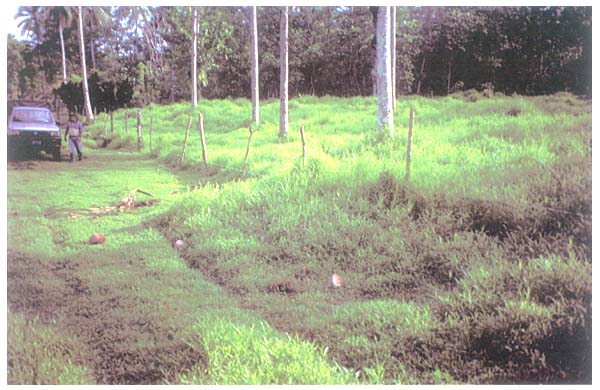
Case Study 3
Crop-pasture sequences increase cattle production Donatien and Ernestine Tsione, Lorelvulko, Santo
This family establishes about one hectare per year of improved pasture by planting commercial crops into t-grass areas which have been cut and burnt. These sites are planted with vegetable crops such as cabbage, onions, corn and tomatoes with the improved pasture vegetatively planted into the final crop. Shortly after final harvest, a fully developed, weed-free pasture is then ready for immediate grazing. Vegetable crops are used for home consumption with the surplus being sold in Luganville markets. The family has also improved about 40% of their 25 ha grazed buffalo grass pasture by planting the legume hetero into dung patches and by discing some t-grass areas and seeding signal grass and legumes.
This improvement has at least doubled their beef enterprise income through an increase in the offtake weight and a reduction in the age of marketed steers and surplus heifers. This has allowed them to achieve a 40–60% gain in price paid per kilogram. Previously, their offtake did not meet Japanese export specifications. With pasture improvement and careful handling to avoid any bruising, they now meet export standards consistently.
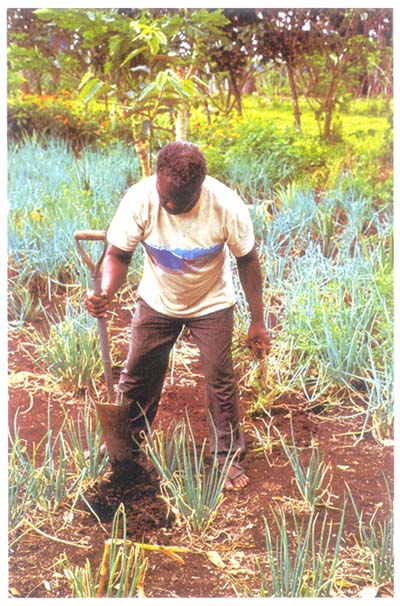 | Donatien Tsione plants pastures into an area of shallots at Lorelvulko, Santo. |